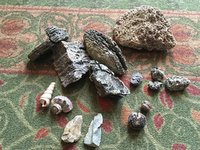Gaea's listener
Yamadori
Hello everyone,
I have been playing with creating an interesting texture for unglazed stoneware pots. I used multicoloured slips and oxides to create this effect.
My question is: are you drawn into them? Would you plant one of your trees in a pot like that? If so, what kind of a tree and what draws you into it? And if not, why not? I understand we all have difference sense of aesthetics and what appeals to some, doesn't necessary appeal to others and that is totally ok. I'm learning about esthetics of bonsai pots myself and while most of my trees are still in the nursery pots, I am in the process of designing and considering different things when it comes to choosing a pot.
I'm pretty happy with the way they turned out and I can see myself potting a juniper into the dark brown one, but my juniper is too big to fit into this pot at this moment, it would have to go through few years of gradual reduction of the root mass.
Thank you so much for your consideration.
I have been playing with creating an interesting texture for unglazed stoneware pots. I used multicoloured slips and oxides to create this effect.
My question is: are you drawn into them? Would you plant one of your trees in a pot like that? If so, what kind of a tree and what draws you into it? And if not, why not? I understand we all have difference sense of aesthetics and what appeals to some, doesn't necessary appeal to others and that is totally ok. I'm learning about esthetics of bonsai pots myself and while most of my trees are still in the nursery pots, I am in the process of designing and considering different things when it comes to choosing a pot.
I'm pretty happy with the way they turned out and I can see myself potting a juniper into the dark brown one, but my juniper is too big to fit into this pot at this moment, it would have to go through few years of gradual reduction of the root mass.
Thank you so much for your consideration.









